The
Holy Eucharist
at Saint James'
Church
We welcome you to the worship of God through the liturgy of
the Anglican Church. Like the early Church (Acts 2:42), we meet each Sunday to
celebrate the Holy Eucharist. Eucharist means "thanksgiving" and
refers to the thanks we give to God for the gift of life, for the continuing
presence of the Holy Spirit, and most of all, for the resurrection of our Lord
Jesus Christ. This service is also referred to as the Mass, the Lord's
Supper, or Holy Communion. Broadly, the service consists of just two
parts: the liturgy of the Word, and the liturgy of the Eucharist. In more
detail, the Holy Eucharist consists of the following parts:
·
The
Gathering of the Community
·
The
Proclamation of the Word
·
Prayers
and Intercessions
·
Holy
Communion
·
Commissioning
What to expect
The following description refers to the sung Eucharist at the 10:00 am service. The 8:15 am service is similar, but is said, without music.
When you enter the church a sidesperson will greet you and give you a bulletin which outlines the order of service. Please let the sidesperson know if you’re new or a visitor to Saint James’, or if you have any questions.
It is the custom upon entering church to kneel in one's pew for a prayer of personal preparation for worship. For many it is also the custom to bow to the altar on entering and leaving the church as an act of reverence for Christ.
Most Anglicans do not talk in church before a service but use this time for personal meditation and devotions. At the end of the service some persons kneel for a private prayer before leaving.
 In
addition to copies of the Bible, you'll find two books in the church pew.
The ‘green book’ is The Book of Alternative Services (BAS),
In
addition to copies of the Bible, you'll find two books in the church pew.
The ‘green book’ is The Book of Alternative Services (BAS), containing the order of service. The modern rite, beginning on p. 185, is normally used,
except on the fourth Sunday of each month, when we follow the 1962
version (p. 230 in the BAS), using the traditional language of the Book of
Common Prayer (BCP). The
‘blue book’ – “Common Praise’ – is the hymn book; for hymns not found
in the blue book, the words are printed on a sheet tucked in with the
service bulletin.
containing the order of service. The modern rite, beginning on p. 185, is normally used,
except on the fourth Sunday of each month, when we follow the 1962
version (p. 230 in the BAS), using the traditional language of the Book of
Common Prayer (BCP). The
‘blue book’ – “Common Praise’ – is the hymn book; for hymns not found
in the blue book, the words are printed on a sheet tucked in with the
service bulletin.
During the Communion itself, the host (wafer) and wine are given either by the priest or by a minister, who is typically a trained layperson. We believe that any Christian is potentially a minister in the sense of having a ministry involving certain talents which are given to the service of God. It is only the priest, however, who can bless the bread and the wine to create the sacrament of the Holy Eucharist.
If you’re not
familiar with Anglican customs, you may wonder when to stand or kneel. Practices
vary, even among individual Anglicans. The general rule is to stand to sing.
We stand, too, to say our affirmation of faith, the Creed; and for the
reading of the Gospel in the Holy Eucharist. Psalms are sung or said sitting or
standing. We sit during readings from the Old Testament or New Testament
Letters, the sermon, and the choir anthem. We stand or kneel for prayer to show
our gratitude to God for accepting us as children or as an act of humility
before God.
Before the Service
As parishioners enter the church, the organist plays a prelude, usually a classical organ piece, which helps set the tone for the Eucharist itself. Immediately before the processional hymn which marks the opening of service, the priest will informally welcome the congregation and make announcements concerning parish activities and events.
The
Gathering of the Community
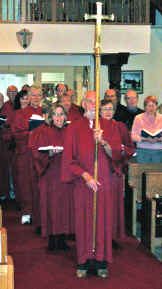 PROCESSIONAL
HYMN: We normally begin our worship with an opening hymn. The hymn number is
noted on the hymn board at the front of the church and in the bulletin. The
procession symbolizes the gathering of God's people to worship.
PROCESSIONAL
HYMN: We normally begin our worship with an opening hymn. The hymn number is
noted on the hymn board at the front of the church and in the bulletin. The
procession symbolizes the gathering of God's people to worship.
OPENING
GREETING (BAS, p. 185): This Greeting reminds us why we are gathered to worship.
SUMMARY
OF THE LAW: (1962 version only) The priest recalls the Great Commandments of
Jesus to love God and neighbour.
YOUTH
CHAT: The priest welcomes children
gathered near the altar, explaining in simple terms the theme of today’s bible
readings, often in the form of a story. The
children then proceed to Church School in Tomkins Hall (basement level).
HYMN
OF PRAISE: A hymn of praise is then offered.
Usually this is the Gloria but during Lent and Advent the more solemn Kyrie
(Lord Have Mercy) or Trisagion (Holy God, Holy and mighty, Holy immortal
One have mercy upon us) are used.
COLLECT
OF THE DAY: The priest concludes the Gathering by leading a prayer that
summarizes the spiritual themes for the day. The collect is printed in the
bulletin.
The
Proclamation of the Word
SCRIPTURE LESSONS: The Anglican
Church uses a lectionary that assigns the readings for each Sunday. In the
course of a three-year cycle, we read through most of the biblical text. Usually
there are three readings: a text from the Old Testament, from the letters of
Paul, and from the Gospels. Reading scripture during a service is based on
ancient forms of Jewish worship. After each reading we allow a period of silence
to respond inwardly to the words in thought and prayer.
- Old
Testament Reading
What we call "Old Testament" is in fact the Hebrew Scriptures referring to God's first promise to Israel through Abraham. Jesus and his disciples would have heard and studied these writings. The New Testament refers to the New Covenant or promise made by God to humanity through Jesus. . You will note that there is a response from the people after each reading - "Thanks be to God". - Gradual
Psalm
Psalms are ancient Hebrew hymns Christians and Jews have sung for thousands of years. "Gradual" from the Latin word "step" is attached to the name of this Psalm since it was sung as the reader walked down the steps to where the lesson would be read. - New
Testament (Epistle)
These reading are mostly from letters (or Epistles) written by Paul and other evangelists offering comfort or instruction to the newly formed Christian churches. Many of their issues are familiar to us today. - Anthem
The choir sings an anthem chosen thematically to reflect the readings and to offer prayer and praise in poetry and music (the anthem is omitted in the summer months). - Gospel
(from old English words "God Spell" meaning "good news")
Because the Gospels provide our best picture of Jesus, we honour the Gospel reading with a procession from the altar with a special book that contains the four Gospels and we stand as we attend to their truth. A special set of responses occurs before and after the Gospel. During the reading of the Gospel, it is customary for all members of the congregation to face the reader, even if this means turning sideways or backwards in the pew.
SERMON: Following the readings the priest (or other preacher) seeks to proclaim God's love reflected in these texts, applying them as much as possible to current issues in the church and the World.
Prayers
and Intercessions
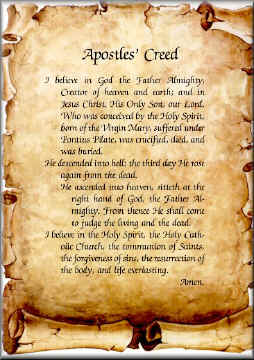 THE
CREED: After the sermon, we stand and recite the Creed (Nicene or Apostles'), a
credal statement that summarizes the basic beliefs of the Christian faith, that
was formulated early in the Church's history. "Credo" literally means
to "place your heart". As followers of Jesus, we place our very hearts
and lives in commitment to the Kingdom of God and the Gospel of Jesus.
THE
CREED: After the sermon, we stand and recite the Creed (Nicene or Apostles'), a
credal statement that summarizes the basic beliefs of the Christian faith, that
was formulated early in the Church's history. "Credo" literally means
to "place your heart". As followers of Jesus, we place our very hearts
and lives in commitment to the Kingdom of God and the Gospel of Jesus.
PRAYERS
OF THE PEOPLE (in church bulletin): Prayer
is an essential part of the Christian's life. Our liturgy frames our prayer by
reminding us of dimensions of our existence. In our prayers, we often name
members of our parish who are ill, as well as parishioners who have recently
died.
CONFESSION
OF SIN: Having heard the Word of God, affirmed our
faith using the Creed and offered prayers for our various needs and concerns, we
take a moment to prepare ourselves for Communion through confession. After the
invitation to "confess our
sins, confident in God’s forgiveness ", a
moment of silence is offered to gather our thoughts about how we understand sin
in our lives and take stock of that for which we are truly sorry and hope to
correct or make amends. Confession has two main parts: identifying the sin and
the intention to address it. While we recite the words together in a general
form, it is intended that in our hearts, we reveal the particular intentions to
God.
The
priest then stands and offers absolution (forgiveness) for our sins through
Jesus Christ. The priest reminds us of the words of scripture that assures us of
God's love for all His creatures.
THE
PEACE: Following the Confession, we stand forgiven and offer a sign of peace to
our neighbour. This is in line with the scriptural admonition that if you have a
grievance with your brother or sister go and settle it before you offer your
gift at the Altar. This is much more than "saying hello to your
neighbour", but rather is a symbol of regard for each person.
Holy
Communion
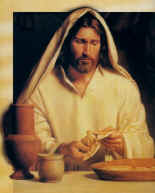
SURSUM
CORDA: Holy Communion begins with the salutation between the Celebrant and the
People, with the priest exhorting the people to "lift up your hearts".
This invitation asks people to place their hearts and minds on the Kingdom of
Heaven where indeed God reigns.
SANCTUS
AND BENEDICTUS: This text comes from Isaiah as the prophet finds himself in the
presence of God and "cries holy unto the Lord". It is a deep
expression of praise that speaks to the majesty of God. This text has
traditionally been set to music by some of the great composers of the church and
in most of our liturgies, we sing the Sanctus and Benedictus.
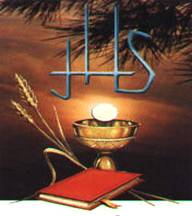 EUCHARISTIC
PRAYER: Using ancient texts that recount the mighty acts of God, our Eucharistic
prayer expresses our profound thanksgiving to our Creator, Redeemer and
Sustainer. We recall the "words of institution" that scripture tells
us Jesus used on his last night on Earth in the holy meal he shared with His
disciples. We take comfort in the promise he made: He will be present at future
celebrations of this meal. As Anglicans, we affirm the Real Presence of Christ
in our Eucharistic celebration. During the Eucharistic prayer, the priest
invokes the Holy Spirit to be present in our celebration. At the conclusion, all
the people affirm the spiritual truth of the prayer by sounding a hearty AMEN.
EUCHARISTIC
PRAYER: Using ancient texts that recount the mighty acts of God, our Eucharistic
prayer expresses our profound thanksgiving to our Creator, Redeemer and
Sustainer. We recall the "words of institution" that scripture tells
us Jesus used on his last night on Earth in the holy meal he shared with His
disciples. We take comfort in the promise he made: He will be present at future
celebrations of this meal. As Anglicans, we affirm the Real Presence of Christ
in our Eucharistic celebration. During the Eucharistic prayer, the priest
invokes the Holy Spirit to be present in our celebration. At the conclusion, all
the people affirm the spiritual truth of the prayer by sounding a hearty AMEN.
THE LORD'S PRAYER: When Jesus taught
his disciples this prayer it was a summary of all prayers. Placed in our liturgy
at this place it again becomes the summation of our prayers to God in blessing
the Bread and Wine.
FRACTION:
The Eucharistic Prayer is followed by the breaking of bread (the Fraction), a
Fraction Sentence, and the Prayer of Humble Access (BCP only). Then the priest
invites the people to come and share in Holy Communion.
AGNUS
DEI: During or immediately
following the fraction (above) we pray to Christ as the perfect sacrificial
offering who atones for the sin of the world ["Behold, the Lamb of God, who takes away the
sin of the world." (John 1:29)], asking for his mercy and his peace.
Receiving the
Sacrament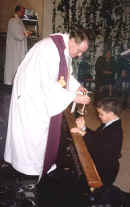
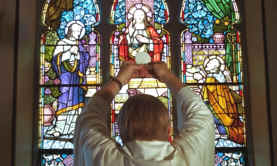 We
practice "Open Communion" in the Anglican Church. If you are a
baptized Christian, you are welcome to receive the Blessed Sacrament with us. A
sidesperson will tell your row when it is time to come forward.
Opportunity is given to receive both the bread and the wine. To receive, simply
place your overlapped hands in front of the minister. The host (wafer) will be
placed in your hands, at which point you may consume it. Another minister will
follow behind with the chalice of wine. Take the base of the chalice and guide
it to your lips for a sip of the wine. If you do not wish to receive the wine,
simply cross your arms over your chest and the minister will pass you by.
We
practice "Open Communion" in the Anglican Church. If you are a
baptized Christian, you are welcome to receive the Blessed Sacrament with us. A
sidesperson will tell your row when it is time to come forward.
Opportunity is given to receive both the bread and the wine. To receive, simply
place your overlapped hands in front of the minister. The host (wafer) will be
placed in your hands, at which point you may consume it. Another minister will
follow behind with the chalice of wine. Take the base of the chalice and guide
it to your lips for a sip of the wine. If you do not wish to receive the wine,
simply cross your arms over your chest and the minister will pass you by.
After
receiving the sacrament people return to their pews for a time of quiet
contemplation. During this period the choir will sing softly. Our post-communion prayer follows
and reminds us of the
spiritual graces we have received.
Commissioning
THE
BLESSING: The traditional blessing by the priest is given, followed by the
Recessional Hymn in which the choir and ministers proceed to the back of the
church. This is symbolic of our leaving worship to go into the world for
service.
THE DISMISSAL: The priest pronounces the dismissal, entreating us to go into the world to love and serve the Lord.
After
the Service
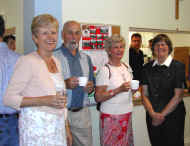 At
the end of the service the organist plays a postlude, and people may enjoy it as
they sit in the pews, or they may proceed quietly to the social gathering which
follows.
At
the end of the service the organist plays a postlude, and people may enjoy it as
they sit in the pews, or they may proceed quietly to the social gathering which
follows.
After the Eucharist, we gather in Tomkins Hall (basement level) for tea, coffee or juice and a chance to chat; in the summer months, we meet instead at the back of the church for this pleasant gathering. We particularly enjoy welcoming newcomers and guests. Do please join us.
![]()
Acknowledgements:
Text adapted from All
Saints' Church, Peterborough, Anglicans
Online, Saint
George's Church, Maplewood NJ
Images from American
Vision, Idumeé,
Church
of St Philip and St James, Mallorca, Saint James' Church, Manotick